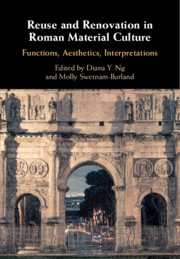Book contents
- Reuse and Renovation in Roman Material Culture
- Reuse and Renovation in Roman Material Culture
- Copyright page
- Contents
- Illustrations
- Contributors
- Acknowledgments
- Introduction: Reuse, Renovation, Reiteration
- Chapter One The Reuse and Redisplay of Honorific Statues in Pompeii
- Chapter Two The Vigiles, Dynastic Succession, and Symbolic Reappropriation in the Caserma dei Vigili at Ostia
- Chapter Three Epigraphy of Appropriation: Retrospective Signatures of Greek Sculptors in the Roman World
- Chapter Four Gateways to the Past: The Hadrianic Architecture of Procession in Pisidian Antioch and Athens
- Chapter Five Visual Literacy and Reuse in the Architecture of Late Imperial Rome
- Chapter Six Urban Transformations at Aphrodisias in Late Antiquity: Destruction or Intentional Preservation?
- Chapter Seven Acquiring the Antique in Byzantine Rome: The Economics of Architectural Reuse at Santa Maria Antiqua
- Chapter Eight The Afterlife of the Amphitheater: Cultural Biography and Social Memory at Tarragona
- Notes
- Index
- References
Chapter Seven - Acquiring the Antique in Byzantine Rome: The Economics of Architectural Reuse at Santa Maria Antiqua
Published online by Cambridge University Press: 17 September 2018
- Reuse and Renovation in Roman Material Culture
- Reuse and Renovation in Roman Material Culture
- Copyright page
- Contents
- Illustrations
- Contributors
- Acknowledgments
- Introduction: Reuse, Renovation, Reiteration
- Chapter One The Reuse and Redisplay of Honorific Statues in Pompeii
- Chapter Two The Vigiles, Dynastic Succession, and Symbolic Reappropriation in the Caserma dei Vigili at Ostia
- Chapter Three Epigraphy of Appropriation: Retrospective Signatures of Greek Sculptors in the Roman World
- Chapter Four Gateways to the Past: The Hadrianic Architecture of Procession in Pisidian Antioch and Athens
- Chapter Five Visual Literacy and Reuse in the Architecture of Late Imperial Rome
- Chapter Six Urban Transformations at Aphrodisias in Late Antiquity: Destruction or Intentional Preservation?
- Chapter Seven Acquiring the Antique in Byzantine Rome: The Economics of Architectural Reuse at Santa Maria Antiqua
- Chapter Eight The Afterlife of the Amphitheater: Cultural Biography and Social Memory at Tarragona
- Notes
- Index
- References
- Type
- Chapter
- Information
- Reuse and Renovation in Roman Material CultureFunctions, Aesthetics, Interpretations, pp. 186 - 207Publisher: Cambridge University PressPrint publication year: 2018
References
- 2
- Cited by



